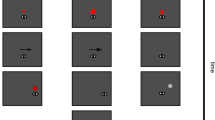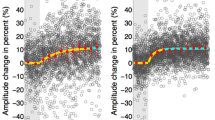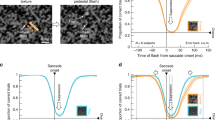Abstract
Controversy exists as to the extent to which the saccadic system, adapted in the so-called ‘gain-shortening paradigm’ for a particular target configuration, transfers the resulting change in saccade metrics to saccades elicited under different circumstances. In order to further assess this problem, we investigated the properties of human saccadic eye movements after visually induced short-term adaptation under a variety of conditions. We observed that saccades both during and after the adaptation did not significantly change their main sequence properties with respect to the pre-adaptation baseline. Saccade velocity profiles remained normal throughout the experiment, and we obtained no evidence that correction saccades were gradually absorbed in the primary saccade. We found that the effect of the short-term adaptation on saccade metrics is not confined to the particular combination of initial eye position and spatial position of the visual target used to induce the adaptation response. Saccades elicited from different initial positions towards targets with the same retinotopic coordinates as in the adaptation phase yield the same level of adaptation. However, our findings indicate that adaptation is confined to a limited range of saccade vectors around the oculocentric coordinates of the adaptation target (‘restricted adaptation field’). Smaller and larger saccades are endowed with significantly lower adaptation values. Moreover, two further experiments showed that a retinal stimulus is not a prerequisite for adaptation to express itself: First, in a double-step experiment, we dissociated the retinal stimulus vector from the required oculomotor response. Second, we also investigated the effect of visually induced adaptation on auditory evoked saccades. In both tasks the adaptation was transferred to the required motor response. Based on our findings, we conclude that short-term adaptation is expressed at a multisensory stage, where saccadic eye movements are represented as desired eye displacement vectors (motor error). Possible neurophysiological implications are discussed.
Similar content being viewed by others
References
Abel LA, Schmidt D, Dell'Osso LF, Daroff RB (1978) Saccadic system plasticity in humans. Ann Neurol 4:313–318
Abrams RA, Dobkin RS, Helfrich MK (1992) Adaptive modification of saccadic eye movements. J Exp Psychol Hum Percept Perform 18:922–933
Albano JE, King WM (1989) Rapid adaptation of saccadic amplitude in humans and monkeys Invest Ophthalmol Vis Sci 30(8):1883–1893
Bahill AT, Clark MR, Stark L (1975) The main sequence: a tool for studying human eye movements. Math Biosci 24:191–204
Blauert J (1983) Spatial hearing: the psychophysics of human sound localization. MIT, Cambridge, Mass
Bruce CJ (1988) Single neuron activity in the monkey's prefrontal cortex. In: Ratric P, Singer W (eds) Neurobiology of neocortex. Wiley, Chichester, pp 297–329
Bruce CJ, Goldberg ME (1985) Primate frontal eye fields. I. Single neurons discharging before saccades. J Neurophysiol 53:603–635
Bruce CJ, Goldberg ME, Bushnell MC, Stanton GB (1985) Primate frontal eye fields. II. Physiological and anatomical correlates of electrically evoked eye movements. J Neurophysiol 54:714–734
Collewijn H, Van der Mark F, Jansen TJ (1975) Precise recording of human eye movements. Vision Res 15:447–450
Deubel H (1987) Adaptivity of gain and direction in oblique saccades. In: O'Regan JK, Lévy-Schoen A (eds) Eye movements: from physiology to cognition. Elsevier North Holland, Amsterdam, pp 181–190
Deubel H (1993) Saccadic adaptation: specificity with respect to spatial parameters and context. D. A. Robinson Festschrift, Eibsee, München
Deubel H, Wolf W, Hauske G (1986) Adaptive gain control of saccadic eye movements. Hum Neurobiol 5:245–253
Erkelens CJ, Hulleman J (1993) Selective adaptation of internally triggered saccades made to visual targets. Exp Brain Res 93:157–164
FitzGibbon EJ, Goldberg ME (1986) Cellular activity in the monkey superior colliculus during short term saccadic adaptation. Soc Neurosci Abstr 12:1187
FitzGibbon EJ, Goldberg ME, Segraves MA (1985) Short term adaptation in the monkey. In: Keller EL, Zee DS (eds) Advances in the biosciences vol 57: adaptative processes in the visual and oculomotor systems. Pergamon Press, Oxford, pp 329–333
Frens MA, Van Opstal AJ (1992) Visually induced changes in auditory-evoked saccades. Eur J Neurosci [Suppl 24]:83
Goldberg ME, Bruce CJ (1990) Primate frontal eye fields. III. Maintenance of a spatially accurate saccade signal. J Neurophysiol 64:489–508
Harris WA (1986) Learned topography: the eye instructs the ear. Trends Neurosci 9:97–99
Henson DB (1978) Corrective saccades: effects of altering visual feedback. Vision Res 18:63–67
Jay MF and Sparks DL (1984) Auditory receptive fields in primate superior colliculus shift with eye position. Nature 309:345–347
King AJ, Palmer AR (1985) Integration of visual and auditory information in bimodal neurones in the guinea-pig superior colliculus. Exp Brain Res 60:492–500
Knudsen EI, Brainard MS (1991) Visual instruction of the neural map of auditory space in the developing optic tectum. Science 253:85–87
Knudsen EI, Knudsen PF (1985) Vision guides the adjustment of auditory localization in young barn owls. Science 230:545–548
Kommerell G, Olivier D, Theopold H (1976) Adaptive programming of phasic and tonic components in saccadic eye movements. Invest Ophthalmol 15:657–660
Lee C, Rohrer WH, Sparks DL (1988) Population coding of saccadic eye movements by neurons in the superior colliculus. Nature 332:357–360
Mack A, Fendrich R, Pleune J (1978) Adaptation to an altered relation between retinal image displacements and saccadic eye movements. Vision Res 18:1321–1327
Mays LE, Sparks DL (1980) Dissociation of visual and saccade related responses in superior colliculus neurons. J Neurophysiol 43:207–232
McIlwain JT (1982) Lateral spread of neural excitation during microstimulation in the intermediate gray layer of cat's superior colliculus. J Neurophysiol 47:167–178
McLaughlin SC (1967) Parametric adjustment in saccadic eye movements. Percept Psychophys 2:359–362
Meredith MA, Stein BE (1986) Visual, auditory and somatosensory convergence on cells in superior colliculus results in multisensory integration. J Neurophysiol 56:640–662
Miller JM, Anstis T, Templeton WB (1981) Saccadic plasticity: parametric adaptive control by visual feedback. J Exp Psychol Human Percept 7:356–366
Optican LM, Robinson DA (1980) Cerebellar adaptive control of primate saccadic system. J Neurophysiol 44:1058–1076
Ottes FP, Van Gisbergen JAM, Eggermont JJ (1986) Visuo-motor fields of the superior colliculus: a quantitative model. Vision Res 26:857–873
Peck CK (1987) Visual-auditory interactions in cat superior colliculus: their role in the control of gaze. Brain Res 420:162–166
Robinson DA (1972) Eye movements evoked by collicular stimulation in the alert monkey. Vision Res 12:1795–1808
Schiller PH, True SD, Conway JL (1980) Deficits in eye movements following frontal eye field and superior colliculus ablations. J Neurophysiol 44:1175–1189
Schlag-Rey M, Schlag J, Dassonville P (1992) How the frontal eye field can impose a saccade goal on superior colliculus neurons. J Neurophysiol 67:1003–1005
Semmlow JL, Gauthier GM, Vercher JL (1987) Short term adaptive modification of saccade amplitude. In: O'Regan JK, Lévy-Schoen A (eds) Eye movements: from physiology to cognition. Elsevier North Holland, Amsterdam, pp 191–200
Van Opstal AJ, Van Gisbergen JAM (1987) Skewness of saccadic velocity profiles: a unifying parameter for normal and slow saccades. Vision Res 27:731–745
Withington-Wray DJ, Binns KE, Keating MJ (1990) The maturation of the superior collicular map of auditory space in the guinea pig is disrupted by developmental visual deprivation. Eur J Neurosci 2:682–692
Author information
Authors and Affiliations
Rights and permissions
About this article
Cite this article
Frens, M.A., van Opstal, A.J. Transfer of short-term adaptation in human saccadic eye movements. Exp Brain Res 100, 293–306 (1994). https://doi.org/10.1007/BF00227199
Received:
Accepted:
Issue Date:
DOI: https://doi.org/10.1007/BF00227199




